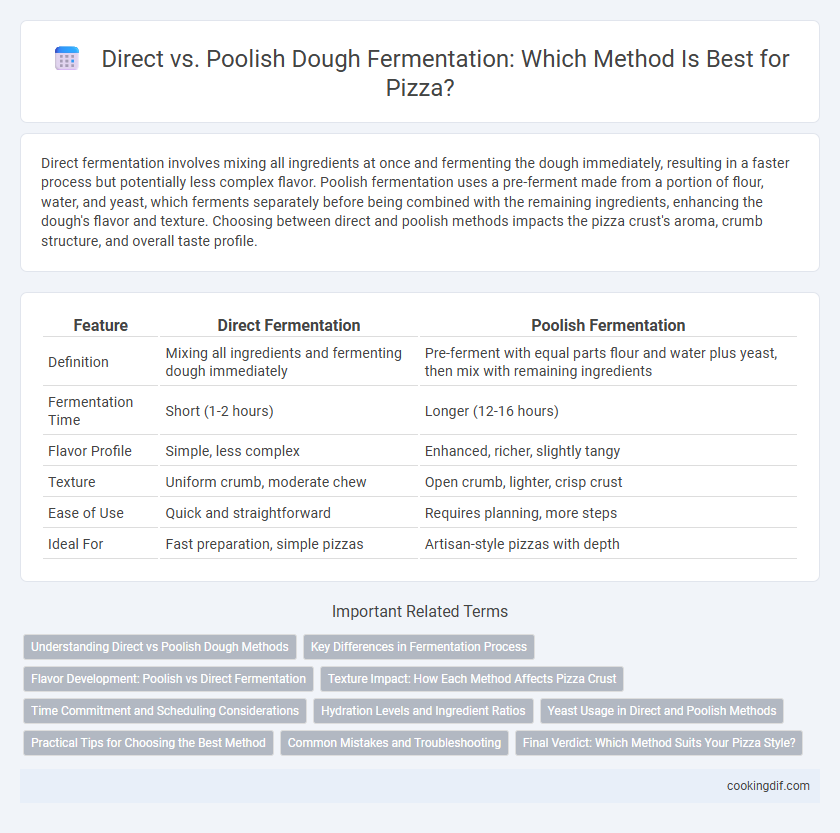Direct fermentation involves mixing all ingredients at once and fermenting the dough immediately, resulting in a faster process but potentially less complex flavor. Poolish fermentation uses a pre-ferment made from a portion of flour, water, and yeast, which ferments separately before being combined with the remaining ingredients, enhancing the dough's flavor and texture. Choosing between direct and poolish methods impacts the pizza crust's aroma, crumb structure, and overall taste profile.
Table of Comparison
| Feature | Direct Fermentation | Poolish Fermentation |
|---|---|---|
| Definition | Mixing all ingredients and fermenting dough immediately | Pre-ferment with equal parts flour and water plus yeast, then mix with remaining ingredients |
| Fermentation Time | Short (1-2 hours) | Longer (12-16 hours) |
| Flavor Profile | Simple, less complex | Enhanced, richer, slightly tangy |
| Texture | Uniform crumb, moderate chew | Open crumb, lighter, crisp crust |
| Ease of Use | Quick and straightforward | Requires planning, more steps |
| Ideal For | Fast preparation, simple pizzas | Artisan-style pizzas with depth |
Understanding Direct vs Poolish Dough Methods
Direct dough fermentation involves mixing all ingredients at once and allowing the dough to rise without pre-fermentation, resulting in faster preparation and a straightforward process. Poolish dough method uses a pre-ferment made from equal parts water and flour with a small amount of yeast, enhancing flavor development, dough extensibility, and crust texture through extended fermentation. Poolish fermentation typically produces a more complex, airy crumb and improved crust characteristics compared to the simpler, quicker direct method.
Key Differences in Fermentation Process
Direct fermentation involves mixing all ingredients at once and fermenting the dough immediately, resulting in a quicker process but less developed flavor. Poolish fermentation uses a pre-ferment made from equal parts flour and water with a small amount of yeast, fermented for 12 to 16 hours to enhance flavor complexity and dough extensibility. The extended fermentation in Poolish leads to improved gas retention and a lighter, airier pizza crust compared to the denser texture from direct fermentation.
Flavor Development: Poolish vs Direct Fermentation
Poolish fermentation enhances flavor complexity by allowing yeast and enzymatic activity to develop organic acids and alcohol during an extended proofing period, resulting in a more nuanced, tangy, and aromatic dough. Direct fermentation shortens this process, producing a milder flavor with less depth because yeast acts primarily during baking rather than throughout a prolonged fermentation. Poolish's layered flavor profile is favored in artisanal pizza doughs for its balance of sweetness, acidity, and subtle fermentation notes.
Texture Impact: How Each Method Affects Pizza Crust
Direct fermentation yields a denser pizza crust with a slightly chewier texture due to shorter fermentation times and less yeast activity. Poolish fermentation enhances gluten development and gas retention, producing a lighter, airier crust with a more complex flavor profile. The choice between direct and poolish methods significantly influences the dough's hydration and fermentation dynamics, directly impacting crust texture and overall eating experience.
Time Commitment and Scheduling Considerations
Direct fermentation requires a shorter resting period, typically between 1 to 2 hours, making it ideal for quick pizza preparation and tight schedules. Poolish fermentation involves a pre-fermentation phase lasting 12 to 16 hours at room temperature, which demands advanced planning but enhances dough flavor and texture. Choosing between direct and poolish methods depends on balancing available time with desired dough complexity and workflow flexibility.
Hydration Levels and Ingredient Ratios
Direct dough fermentation typically involves a higher hydration level, around 65-70%, allowing faster fermentation and a softer crumb. Poolish prefers a 100% hydration starter, mixing equal parts flour and water, creating a highly active pre-ferment that enhances flavor complexity and dough extensibility. Ingredient ratios in Poolish usually include a small amount of yeast in the pre-ferment, which extends fermentation time and improves gluten development compared to the straightforward Direct method.
Yeast Usage in Direct and Poolish Methods
Direct dough fermentation uses yeast added straight to the flour and water mixture, resulting in faster fermentation but higher yeast quantities to achieve the desired rise. In contrast, the poolish method employs a pre-ferment made with equal parts flour and water plus a small amount of yeast, which ferments for several hours before being mixed into the final dough. This technique reduces overall yeast usage, enhances flavor complexity, and improves dough extensibility, making it favored for artisanal pizza crusts.
Practical Tips for Choosing the Best Method
Direct fermentation delivers faster dough preparation and a more straightforward process, ideal for busy pizzerias aiming for consistent results in less than 24 hours. Poolish fermentation, with its pre-fermented yeast mixture, enhances flavor complexity and texture by allowing a slower, more controlled rise, suitable for artisan-style pizzas demanding depth and chewiness. Opt for direct fermentation when speed and simplicity matter, and choose poolish for superior taste and extended fermentation benefits.
Common Mistakes and Troubleshooting
Direct dough fermentation often leads to uneven gluten development and underproofing, resulting in dense crusts if not timed correctly. Poolish fermentation requires precise hydration and fermentation temperature control to avoid overly sticky dough or off-flavors due to excessive acidity. Troubleshooting common issues includes adjusting fermentation time based on ambient temperature and ensuring proper yeast quantity to balance flavor and texture in both methods.
Final Verdict: Which Method Suits Your Pizza Style?
Direct fermentation produces a quick and straightforward dough ideal for thin-crust pizzas needing a tender, soft texture, while poolish fermentation develops complex flavors and chewy textures perfect for artisanal, rustic styles. Poolish requires longer fermentation times, enhancing gluten development and imparting a slight tang, benefiting Neapolitan or sourdough-inspired pizzas. Choose direct fermentation for fast preparation and subtle taste or opt for poolish to achieve depth in flavor and texture tailored to your pizza style.
Direct vs Poolish for dough fermentation Infographic

 cookingdif.com
cookingdif.com